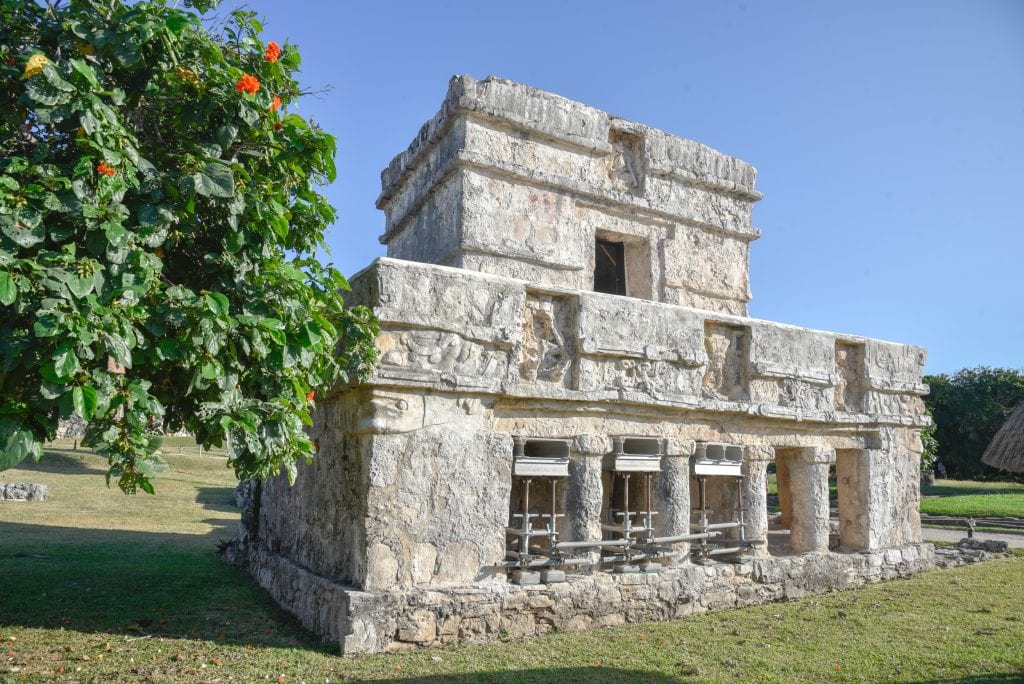If you’re visiting the Yucatan Peninsula in Mexico, you can’t miss the Tulum Ruins, a Mayan archaeological site perched on a cliff that overlooks the Caribbean Sea.
The Mayan Ruins in Tulum are a magnificent seaport fortress , if you consider that they were built on a steep ocean cliff. The archaeological site is surrounded by thick and large limestone walls that enclose the city from all three sides; these amazing walls provided protection for the Mayans during the height of their civilization.
Apart from the archaeological complex, you can also see cactus flowers and palm trees growing around and iguanas lazing in the sun.
A History of the Tulum Ruins
Constructed between 1200-1500 CE, Tulum was originally known as Zamá, which means “City of Dawn.” It was a thriving capital and trading city owing to the fact that it had access to both land and water trade routes. It was easily defensible and become a pivotal trading center for nearby Chitzen Itza. The region was inhabited as far back as 564 CE and the city continued to thrive until the Spanish arrived and destroyed it in 1518.
Around 500 people lived in the centre , only prominent people lived in Tulum, the city was an important transportation hub , while up to 10,000 lived outside the walls by the time Spanish arrived. Much of the local population succumbed to diseases introduced by the Europeans not long after their arrival and conquest. After that, Tulum was abandoned and left to the jungle.
After its rediscovery in 1840, it became one of the most popular ruins in Mexico.
It’s incredibly beautiful, especially given its location near the ocean. Several buildings are still intact while many more lay in varying stages of decay.
There are several well-preserved structures, but among the most important ones you should not miss are The Temple of the Frescoes, El Castillo Pyramid, House of the Columns and Temple of the Descending God.
Temple of the Frescoes

You have the beautiful Temple of the Frescoes. (Note: These are not original names. They are names archaeologists gave to the buildings.) This is one of the most important structures in Tulum. It was also used as an observatory for tracking the sun. There are several carvings of the “diving god” (Venus) found here. The outer temple has sculptures in three niches, including a central figure representing the descending god Venus and human figures carved into the frieze.
Watch Towers

The southwest and northwest corners there are small structures that have been identified as watch towers, showing again how well defended the city was. Tulum was protected on one side by a huge cliff, which would have taken a great deal of energy and work on behalf of the Maya.
Gateways

There are five narrow gateways in the wall, with two each on the north and south sides and one on the west. A small cenote on the northern side of the wall provided the entire city with water.
The Castillo

The Castillo (the castle) is the largest building in Tulum and it likely served as a landmark for sailors. There are serpent motifs carved into the upper rooms, and the building was originally painted red and covered in stucco.
The House of Columns

The House of Columns is one of the more complex structures in Tulum. It was likely built in stages. Shaped like an “L,” six columns supported the roof. It was once served the residence of the Mayan Leaders.
Nearby, a shrine marks a break in the barrier reef that is opposite the site. Here you’ll find a cove and beach that would have been perfect for trading canoes coming in.
When to Visit the Ruins of Tulum
Today, the area around the ruins is now very developed with shops, bars, and even a Starbucks. There are a lot of people here too. It’s best to come between 8-9am or after 3-4pm to avoid the sun as well as all the day-trippers from Playa Del Carmen and Cancun. This place gets packed so arrive early or late to beat the crowds.
Inside the archaeological complex there are many boards with explanation in Spanish and English, so we did not have a problem to understand the meaning of structures. This means that visiting without a tour guide is easy to do.
You can see the ruins in around one hour, although i could have spent so much time there.
You can also swim at the Tulum ruins beach (bring a bathing suit!) under the old ruined fortress, which is a cool experience. However, the beach fills up fast so if you want to swim be sure to arrive early!
Though the ruins are quite touristy , they a beautiful and awe-inspiring and are definitely worth a visit. Even if you’re not a history buff , there is a lot to see and appreciate.
How to Visit the Ruins of Tulum
The ruins are located around 3 kilometers (1.8 miles) from the town of Tulum. You can reach the ruins in just under 2 hours from Cancun and in around 45 minutes from Rivera Maya.
From the town of Tulum, you can reach the ruins on foot in under an hour. Otherwise, you can take a 10-minute taxi.
The ruins are open daily from 9am-5pm and costs approximately 95 MXN ($4 USD). Parking costs around 100 MXN ($5 USD). A very reasonable price and children under 13 are free.


